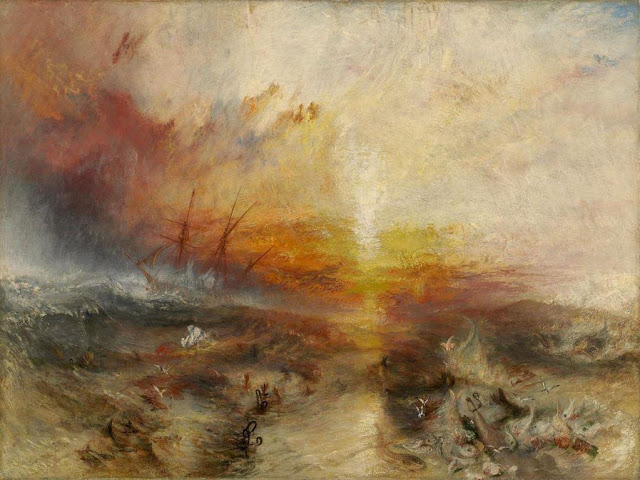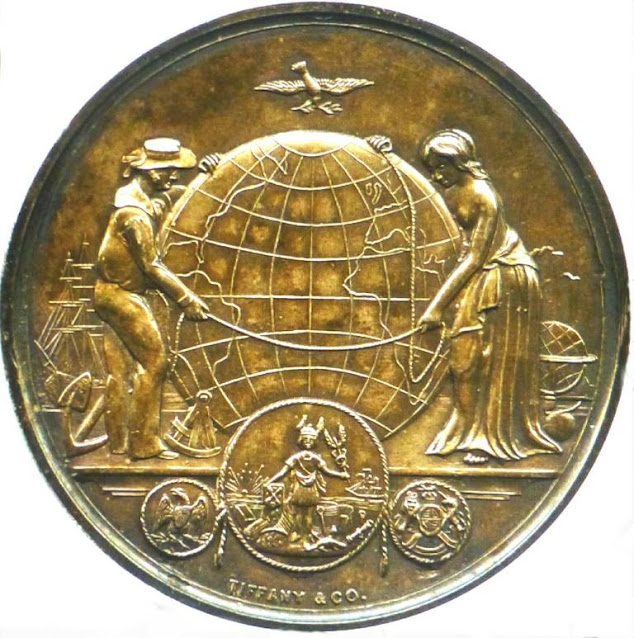From Slavery to Sponges Part III: Admiral George William Preedy CB
J.M.W. Turner was inspired to paint ‘The Slave Ship’ in 1840 after reading The History and Abolition of the Slave Trade by Thomas Clarkson. In 1781, the captain of the slave ship Zong had ordered 133 slaves to be thrown overboard so that insurance payments could be collected. This event probably inspired Turner to create his landscape and to choose to coincide its exhibition with a meeting of the British Anti-Slavery Society.
My
blogging is less frequent nowadays, but every so often researching Budleigh’s
local history sends me back to the keyboard to record yet another curious and
sometimes important discovery.
The
latest find relates to my earlier investigation into the early life of the 19th
century scientist Henry Carter FRS, and specifically into the question of his
education. Who paid for it? And why? And how come his benefactor, Budleigh
resident John Campbell was such a wealthy man?
The
answer came from the discovery of the Campbell family’s plantations in the West
Indies
as
I wrote at http://budleighpastandpresent.blogspot.com/2015/10/from-slavery-to-sponges-imagining_29.html
Of
course John Campbell was not the only wealthy Devon resident whose past we look
on today as tainted by a criminal disregard of human rights. The county has had something of a bad press
in recent years with regard to its involvement in the early slave trade. Plymouth
City Council refused in 1994 to provide funds for celebrations marking the 400th
anniversary of the death of Sir John Hawkins; the Elizabethan seafarer knighted
by Queen Elizabeth I is of course notorious for his pioneering of African
slaving expeditions. The coat of arms seen above, granted to him in 1565, even includes ‘a
demi-Moor proper bound captive’.
As
recently as 2013, Lympstone resident Graham Martin, Chairman of the Exeter
branch of Anti-Slavery International, wrote in a letter published by the Express & Echo newspaper to protest
that Exeter’s Royal Albert Memorial Museum, in its staging of the ‘West Country
to World’s End exhibition’, had failed to mention the involvement of Hawkins and his second cousin Sir Francis
Drake in the Elizabethan slave trade.
School
children whom he had seen visiting the exhibition with its ‘glossy image’ of
such national heroes had gained ‘an incomplete picture’ of their careers.
I’m
sure that Mr Martin wasn’t the only visitor to the exhibition who felt that its
curator had turned a blind eye to what many consider as a stain on the
reputation of the so-called civilised West to rank with crimes such as genocide.
I did think at the time that a display of RAMM’s slave chains, one of its lesser known artefacts, would have been a useful tool to educate visitors to the exhibition, including the children that Graham Martin had seen.
So it’s heartening to know that many Devon people later became noted for their support for slavery’s abolition. As Dr Todd Gray recently pointed out, following the tragic destruction of the Royal Clarence Hotel last October, this celebrated Exeter building became ‘the place to be’ in the 18th and 19th centuries: ‘it was where the anti-slavery people met in the 1700s and 1800s; this is where they planned abolition.’
Above: The marble statue of Lord Rolle by Edward Bowring Stephens, in the entrance hall of Bicton House
Some of course supported abolition knowing
that they would be compensated: John Rolle who
became Lord Rolle of Stevenstone and Bicton
and owned plantations in the West Indies as well as extensive estates in
Devon, is said to have received £4,333 in exchange for freeing 377 slaves, the
largest holding in the Bahamas.
Above: Portrait of General Simcoe by George Theodore Berthon
General John Graves Simcoe (1752-1806) on the other hand was an abolitionist who can’t be accused of such financial motivation.
The blue plaque outside his Budleigh Salterton summer residence on Fore Street Hill rightly notes that during his administration of Upper Canada between 1791 and 1796 he ‘put in motion arrangements for the abolition of slavery many years before British legislation was enacted’.
Above: The gold medal struck to mark the successful laying of the 1858 transatlantic telegraph cable
To
the history of abolitionists in Devon one should perhaps add the name of Admiral
George William Preedy CB, the subject of a forthcoming Fairlynch Museum
exhibition and a former Budleigh resident.
Above: An illustration of the episode of the Agamemnon's meeting with a whale in mid-Atlantic
This
distinguished naval officer, though not Devon-born, is celebrated mainly for
his captaincy of HMS Agamemnon which
was involved in the laying of the first successful transatlantic telegraph
cable in 1858.
What
is not widely known is the role played by Preedy as a young midshipman during
the Royal Navy’s campaign against the slave ships.
HMS Rattlesnake, painted in 1853 by Sir Oswald Walters Brierly, was in the same class as HMS Ranger on which Preedy served
Image credit: National Maritime museum, London
He entered the Navy on 12 November 1828 as a volunteer on board HMS Ranger, a 28-gun frigate. Under its captain, William Walpole, he sailed from Portsmouth on 3 January 1829, heading for Jamaica.
When Ranger was sold in 1832, Preedy followed Captain Walpole on HMS Pallas, again sailing for the West Indies on 20 January that year.
Preedy
is recorded as being constantly engaged in the suppression of the slave trade
until May 1834. On one occasion, it seems, he served on HMS Nimble, a five-gun schooner, which was
employed on anti-slave trade patrols from 1826 until 1834 when the ship was
wrecked.
The former slave ship HMS Black Joke (left) fires on
the Spanish ship El Almirante before capturing her, January 1829 Painting by
Nicholas Matthews Condy
Image credit: Royal Naval Museum
Image credit: Royal Naval Museum
Contemporary
accounts leave one in no doubt that this terrible trade was still thriving in
spite of the fact that Britain had signed abolition treaties with Spain and
Portugal in 1818.
Above: A plan of the slave ship Brookes, showing how 454 slaves were accommodated on board. This same ship had reportedly carried as many as 609 people. Image published by the Society for Effecting the Abolition of the Slave Trade
Britain itself had already outlawed the Atlantic slave trade, making it illegal for our ships to transport slaves and the Royal Navy had established a West Africa Squadron to enforce the ban. The British government had consequently negotiated treaties with other countries to give the Royal Navy the right to intercept and search their ships for slaves.
A notable exception, it seems, was the United States, which refused such permission. The 1807 Act Prohibiting Importation of Slaves had technically abolished the intercontinental slave trade in the United States but the ban was not widely enforced and many of the slave ships which escaped the blockade were destined for the southern United States.
Britain itself had already outlawed the Atlantic slave trade, making it illegal for our ships to transport slaves and the Royal Navy had established a West Africa Squadron to enforce the ban. The British government had consequently negotiated treaties with other countries to give the Royal Navy the right to intercept and search their ships for slaves.
A notable exception, it seems, was the United States, which refused such permission. The 1807 Act Prohibiting Importation of Slaves had technically abolished the intercontinental slave trade in the United States but the ban was not widely enforced and many of the slave ships which escaped the blockade were destined for the southern United States.
On
13 July 1832, off the Isle of Pines, the second largest island of Cuba, Nimble
detained the Portuguese slave ship Hebe
with its master, Domingo Jozéd Almeida. The 401
slaves on board, were landed at Nassau and the case was taken to Sierra Leone
where the British and Portuguese Court of Mixed Commission, on 25 Oct 1832,
sentenced the vessel to be condemned and the surviving slaves to be emancipated.
On 10 November 1833 Nimble captured
the Spanish slave ship Joaquina, carrying 348 Africans, after a
battle near the Isle of Pines. The Spanish
captain and two captive Africans were killed in the battle, another African
died later of his wounds, and Joaquina sank.
The account of the episode was graphically
described by Nimble’s Commander, Lieutenant
Charles Bolton, in a letter written a week later and dated16 November:
‘I beg to acquaint you, that I arrived this day, at this port, in
his Britannic Majesty's schooner, Nimble,
with the Spanish slave-schooner, Joaquina, captured on the morning
of the 10th inst. off the Isle of Pines. At daylight on the 10th inst. a sail
was discovered about 9 or 10 miles to leeward, standing in for land. All sail
was immediately made in chase, and having greatly the superiority of sailing, I
soon made her out to be a large schooner, which we were closing very fast. When
within three or four miles the stranger, perceiving there was no chance of
escaping by sailing, wore round, shortened sail, and hove-to to receive us ;
being then seven or eight miles from the south-west point of the Isle of Pines.
I soon afterwards took in studding-sails and square sail, and prepared for action,
still bearing down upon him; he then hoisted Spanish colours and fired a blank
gun, when I hoisted our colours, and as soon as we were within musket-shot (to
ascertain positively what he was) I ordered two muskets to be fired over him,
which he returned by a well-directed shot from a long 12-pounder.
I immediately opened fire upon him, closing as quickly as
possible. The wind now becoming very light, he continued receiving and
returning our fire until within half pistol-shot, when, having received two
8-pound shot between wind and water, several through his upper works and sails,
his mainmast cut nearly through, and rigging much damaged, the captain
desperately wounded (since dead), he struck his colours, and cried for quarter.
His defence was most obstinate and desperate, continued nearly an hour, and he
fought worthy of a better cause.’
I
am sure that Graham Martin will approve of our forthcoming tribute to a local
hero. The exhibition opens on Friday 14 April 2017 and is called ‘Admiral Preedy and the Victorian Internet’.
A talk under the same title is being given by Fairlynch Museum Chairman Trevor Waddington on Sunday 9 April, in County Hall, Topsham Road, Exeter. The talk is part of the Devon-Newfoundland Heritage Forum being organised by the Devonshire Association and the Devon Family History Society (DFHS) from 3-16 April 2017.
A talk under the same title is being given by Fairlynch Museum Chairman Trevor Waddington on Sunday 9 April, in County Hall, Topsham Road, Exeter. The talk is part of the Devon-Newfoundland Heritage Forum being organised by the Devonshire Association and the Devon Family History Society (DFHS) from 3-16 April 2017.

















Thank you for researching this topic and including the aspects of slavery.
ReplyDelete